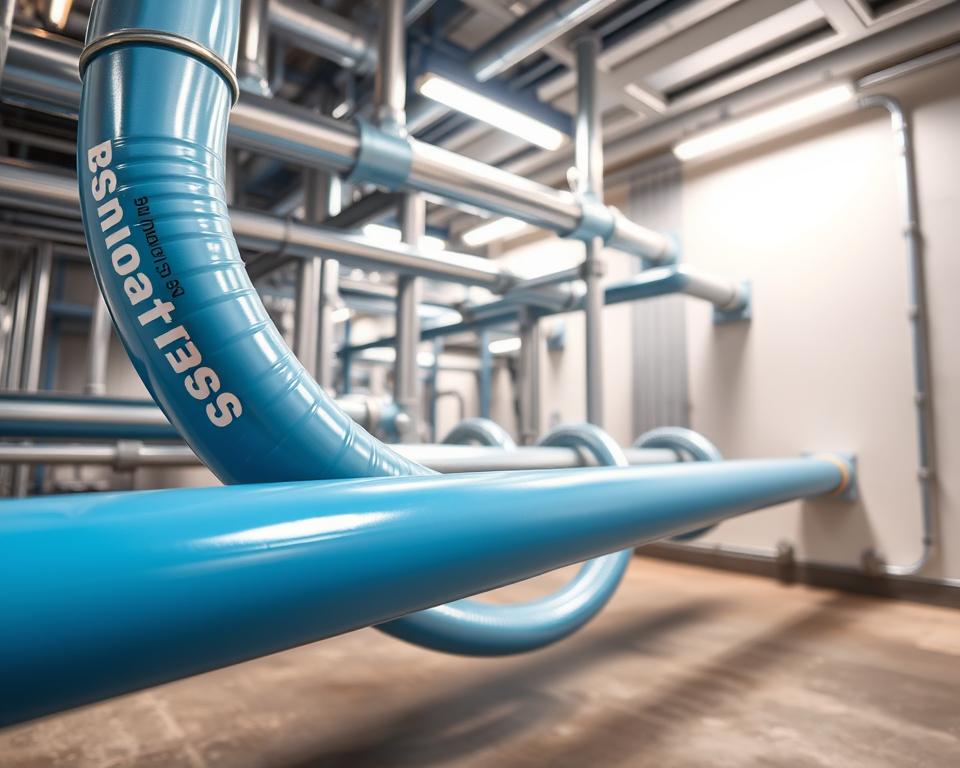Your Complete Guide to PVC Pipe in Compressed Air Systems
You might be surprised to learn that a failure in a compressed air system can unleash power on par with dynamite. Countless operations remain oblivious to the risks of certain piping systems they employ. This guide explains why safety should come first when using PVC air hose.
Despite growing interest in certain materials, OSHA strictly prohibits their use in above-ground applications. Over time, exposure to oils and temperature changes weakens them, leading to catastrophic failures. Even at “safe” pressure ratings, the risk of explosions remains high.
For reliable alternatives, Installation Parts Supply offers durable solutions like aluminum. Using approved materials saves you from fines and enhances safety. Let’s explore how to build a safer system.

Core Messages
- OSHA prohibits specific piping for air lines because of blast hazards.
- Pressure ratings drop as temperatures fluctuate.
- Brittleness worsens over time, increasing failure risks.
- Aluminum piping offers a safer alternative.
- Invest wisely to dodge fines and protect staff.
Why You Shouldn’t Use PVC for Compressed Air
PVC makers caution never to employ it in high-pressure air setups. Compressed air carries destructive energy; a burst is like a dynamite blast. Material selection is the linchpin of air-system safety.
- Brittleness: Below-freezing conditions render PVC dangerously brittle.
- Adhesive failures: Joints weaken when exposed to compressor oils or temperature swings.
- Misleading ratings: Most shops run above 110°F, slashing rated pressure in two.
After a PVC burst hurt staff, OSHA levied a $110,000 fine. The “heat of compression” further reduces safe operating limits, a factor often overlooked in ratings.
“Above-ground use of certain plastics for compressed air violates OSHA standards due to explosion risks.”
Metal alternatives fail more predictably, bending rather than fragmenting. Fragments from PVC blasts can hurl past 50 feet, embedding dangerously.
Workshops face daily temperature fluctuations that accelerate material degradation. A decade’s UV and chemical attack weakens plastic, so small leaks too often balloon into disasters.
Best Materials Instead of PVC for Air Lines
Aluminum air lines deliver superior safety and leak reduction. Black pipe vs. aluminum: aluminum wins with 90% fewer leaks. Their lightweight design and corrosion resistance make them ideal for long-term use.
Snap-together modular aluminum cuts installation hours. Prebuilt snap-together aluminum runs come from Installation Parts Supply. A car plant saw a 40% drop in labor expenses after aluminum installation.
- Copper: Ideal in sterile environments for its germ-killing copper surface. Requires soldering expertise.
- Stainless Steel: Stainless steel stands up to salty, moist conditions.
- ABS/HDPE: Chemical-resistant for labs and factories handling solvents.
“Our aluminum retrofit reduced energy waste by 15%—paying for itself in 18 months.”
Don’t ignore torque specs. Too tight splits fittings; too loose lets air escape. Stick to recommended 25–30 ft-lb torque for aluminum.
For food-grade applications, NSF-certified options ensure air purity. Choose pipe rated for your specific operating environment.
Material Selection Guide for Compressed Air
Consider cost, compliance, and efficiency in your pipe decision. One plant slashed $12k per year by adopting aluminum lines. Here’s how to make the right choice.
| Material | Cost (per ft) | Maintenance | ROI Time |
|---|---|---|---|
| Aluminum | $8.50 | Low | 18 months |
| Black Pipe | $5.00 | High | N/A |
| Copper | $10.20 | Medium | 24 months |
Temperature matters. Aluminum handles -40°F to 200°F, while plastics crack below freezing. Use stainless steel where solvents are present.
Pro Tip: Use leak-loss math to estimate ROI. A 10% air leak in 50 HP equals about $3,500 annually.
- Ensure your pipe PSI rating exceeds system pressure.
- Verify your system meets OSHA welding and pressure-test rules.
- Request a free system audit from Installation Parts Supply.
“Our aluminum retrofit cut energy waste by 15%—paying for itself in 18 months.”
Hire pros for big installs to guarantee airtight connections. Always verify warranty terms—some materials cover 10+ years.
Bringing It All Together
Smart material selection protects life and wallet. Older systems account for 92% of accidents due to degraded piping. Aluminum offers 99.8% reliability, making it a smart long-term choice.
Remember:
- Never use pipes that can fragment violently.
- Opt for corrosion-resistant metals like aluminum or stainless steel.
- Failing to comply can cost you big in fines and claims.
Upgrade now and secure your workplace. Installation Parts Supply provides same-day quotes and limited-time discounts on starter kits. Download our free maintenance template or call for emergency replacements.
Invest in secure lines now to protect your crew.

